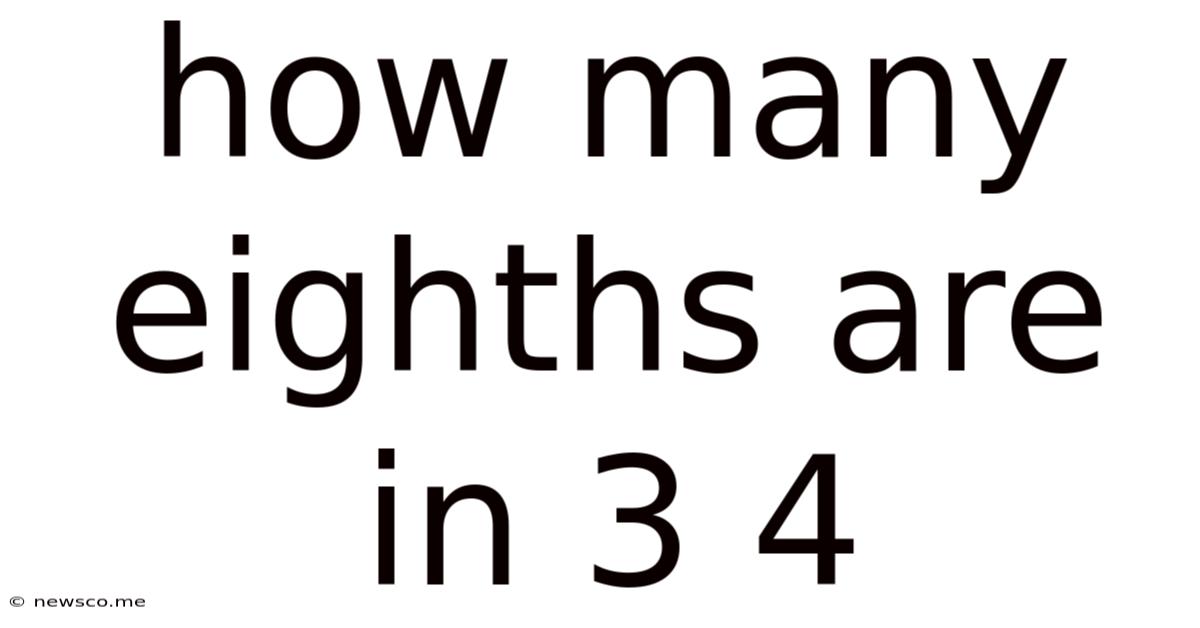How Many Eighths Are In 3 4
News Co
May 07, 2025 · 4 min read

Table of Contents
How Many Eighths Are in 3/4? A Comprehensive Guide to Fraction Conversions
Understanding fractions is fundamental to mathematics, and mastering fraction conversions is key to success in various fields, from baking to engineering. This comprehensive guide will delve into the question: "How many eighths are in 3/4?" We'll explore this problem in detail, covering different methods of solution, explaining the underlying principles, and providing practical examples to solidify your understanding. We'll also touch upon broader applications of fraction conversion and its importance in real-world scenarios.
Understanding Fractions: A Quick Refresher
Before diving into the conversion, let's briefly review the basics of fractions. A fraction represents a part of a whole. It's composed of two main parts:
- Numerator: The top number, indicating the number of parts you have.
- Denominator: The bottom number, indicating the total number of equal parts the whole is divided into.
For example, in the fraction 3/4, 3 is the numerator (you have 3 parts) and 4 is the denominator (the whole is divided into 4 equal parts).
Method 1: Finding the Equivalent Fraction
The most straightforward way to determine how many eighths are in 3/4 is to find an equivalent fraction with a denominator of 8. This involves finding a number that, when multiplied by the denominator of 3/4 (which is 4), results in 8. That number is 2 (because 4 x 2 = 8).
Crucial Rule: To maintain the value of the fraction, whatever you multiply the denominator by, you must also multiply the numerator by the same number.
Therefore:
(3/4) x (2/2) = 6/8
This shows that 3/4 is equivalent to 6/8. Therefore, there are six eighths in three quarters.
Method 2: Visual Representation
Visualizing fractions can significantly aid understanding. Imagine a pizza cut into four equal slices. If you have three of those slices (3/4 of the pizza), how many slices would you have if the pizza were cut into eight equal slices instead?
If you cut each of the original four slices in half, you'd now have eight slices. The three slices you initially had would now be represented by six of the smaller slices (6/8). This visually confirms that 3/4 is equal to 6/8.
Method 3: Using Decimal Equivalents
Another approach involves converting both fractions to their decimal equivalents.
- 3/4: 3 divided by 4 = 0.75
- x/8: To find the equivalent number of eighths, we need to find 'x' such that x/8 = 0.75. Multiplying both sides by 8 gives x = 0.75 * 8 = 6. Therefore, x = 6.
This confirms that 6/8 is equivalent to 3/4.
Expanding the Concept: Working with Different Fractions
The methods outlined above can be applied to convert any fraction to an equivalent fraction with a different denominator. Let's consider a few examples:
Example 1: How many twelfths are in 2/3?
- Find the multiplier: 3 (denominator of 2/3) needs to be multiplied by 4 to get 12.
- Apply the multiplier to both numerator and denominator: (2/3) x (4/4) = 8/12
- Answer: There are eight twelfths in two thirds.
Example 2: How many sixteenths are in 5/8?
- Find the multiplier: 8 (denominator of 5/8) needs to be multiplied by 2 to get 16.
- Apply the multiplier to both numerator and denominator: (5/8) x (2/2) = 10/16
- Answer: There are ten sixteenths in five eighths.
Practical Applications of Fraction Conversion
The ability to convert fractions is crucial in many real-world situations:
- Cooking and Baking: Recipes often require precise measurements. Converting fractions to ensure you have the correct amount of ingredients is essential for successful cooking and baking.
- Construction and Engineering: Precise measurements are paramount in construction and engineering. Converting fractions ensures accurate calculations and prevents errors.
- Finance: Understanding fractions is important for managing finances, calculating percentages, and understanding interest rates.
- Data Analysis: In data analysis, converting fractions to a common denominator facilitates comparison and interpretation of data.
Importance of Mastering Fraction Conversions for Students
For students, mastering fraction conversion is fundamental to progressing in mathematics. It forms the basis for understanding more complex mathematical concepts like:
- Algebra: Solving equations often involves manipulating fractions.
- Geometry: Calculations involving areas and volumes frequently utilize fractions.
- Calculus: A solid understanding of fractions is essential for tackling calculus problems.
Troubleshooting Common Mistakes
A common mistake when converting fractions is forgetting to multiply both the numerator and the denominator by the same number. This will result in an incorrect equivalent fraction. Always remember that multiplying both the numerator and denominator by the same number (other than zero) maintains the value of the fraction.
Conclusion: Embrace the Power of Fraction Conversion
This comprehensive guide has demonstrated how to determine how many eighths are in 3/4 and explored various methods for converting fractions. Understanding fraction conversion is a vital skill with wide-ranging applications. By mastering this skill, you will enhance your problem-solving capabilities in various fields and build a strong foundation for more advanced mathematical concepts. Practice consistently, and you will find fraction conversion becomes second nature! Remember the key principle: whatever you do to the bottom, you must do to the top to maintain the value of your fraction.
Latest Posts
Related Post
Thank you for visiting our website which covers about How Many Eighths Are In 3 4 . We hope the information provided has been useful to you. Feel free to contact us if you have any questions or need further assistance. See you next time and don't miss to bookmark.